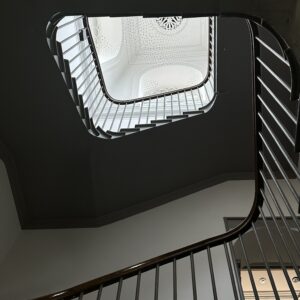
- Identify your key responsibilities and list the main areas of work you have been involved in.
As a member of the TBG team, my main research focus has been to explore aspects of the Old College of Edinburgh that overlap with the history of the struggle for gender affirmation, specifically looking at the impact of gender on access to education.
Our shared goal was to develop a comprehensive research proposal by investigating with my teammates, including display, images, literature review and workshops. In that way, I have extensively researched TBG using resources such as the National Library of Scotland and the official TBG website throughout my studies. I have used ‘The Normal’ as a case study, an installation dealing with racism and feminism. It exemplifies the successful fusion of modern art installation and classical architecture.
The team also enjoyed visiting the gallery last week and having an in-depth conversation with James, who showed us a floor plan and gave us a brief overview of the gallery’s past function as a natural history museum. James used three different coloured Post-it notes as three narrative perspectives of the curatorial process. He supported us in brainstorming and expanding our ideas to find art collections that fit the research theme. With this in mind, we revisited our respective goals and added Enlightenment narrative threads to link the Old College and research projects. We began to conceptualise the presentation of the results of this research, which will consist of short essays and a considerable number of images of the collection.
As we advance, I will continue to focus on my primary enquiry into gender and access to education. This includes continued offline access to rare literature archives on gender affirmation and online literature searches. In this multifaceted project, I aim to contribute meaningfully to the team’s collective understanding and deepen my knowledge of the intricacies and complexities of curatorial practice in different cultural contexts.

- Looking ahead, list your key objectives for the GRP. 3-7 SMART (Specific, Measurable, Achievable, Relevant and Timed) objectives with realistic timescales and focused outcomes should be noted.
1. Travelling together to libraries and galleries to learn about the history of the TRG when it was conceived as a natural history museum, to deepen our understanding of the TRG as a building, to make connections to the critical issues written about in the group’s brief, and to read widely on related materials that can be used as examples for individual or group stories.2. liaise actively with the TRG team to develop the research themes we will be exhibiting next March and complement each other to start compiling an inventory of the collections.
3. The group expects to have completed a cursory study of the collection by December and will liaise with the CRC in an attempt to contact the superintendent for a tour of the collection in January, as well as start to work on an Excel spreadsheet to establish a list of images to be eventually displayed. This should be completed by February
4. according to my plan, I expect to collect documentation on the Edinburgh Seven, including the legal requirements for women’s enrolment in Scotland, by December. As I have already selected the Edinburgh Seven as my case study, I will be focusing on Sophia Jex-Blake’s exploits, including the legal limitations of her application to university and the trials and tribulations of her enrolment, which do not appear to have a solid intuitive connection to Old College, which means that I will need to spend more effort finding potential links between them.
- Discursive self-reflection
Our team completed two library group discussions, extensive data searches, offline discussions at TRG, and productive interactions with James. Through these interactions, I understood the social construction of TRG as a multi-purpose exhibition space that embraces architectural nuances, historical and cultural contexts, and the logic of modern and contemporary art. In our pursuit of individual sub-themes, I focused on exploring the history of access to education, particularly emphasising how gender affects this access. I discovered the exciting story of the Edinburgh Seven through a literature search, through which I found common ground to use in writing my story from three perspectives:
- the official website of the University of Edinburgh
- the official website of British Legislation
- The History of the Enlightenment
Reflecting on my role in teamwork, I see that my strength lies in active participation in workshops. Over the past four years of my internship experience, I have continued to improve my productivity. I have become proficient in writing and analysing data and articles through new media operations and statistics expertise. However, I have one distinct weakness: I tend to be less articulate in seminars, often listening rather than actively sharing my opinions, mainly because I am not confident enough in my English. From now on, I acknowledge the need to communicate more proactively and build deeper connections with teammates and staff in partner organisations.
At the same time, I suggest utilising the unique strengths of each team member to improve team performance. For example, Thais, with her buoyant cheerfulness and efficiency, can lead the team, criticise and provide feedback to our managers. Amy’s local expertise made her an invaluable resource in deepening our understanding of Edinburgh’s history, culture and art scene. Given my proficiency in writing exhibition programmes, art criticism and information gathering, I can contribute to organising documentation and producing texts. With internships in significant galleries, Hao Wen is adept at communicating and collaborating effectively with staff, and Weile’s knowledge of community art brings a new perspective to our art research.

Leave a Reply